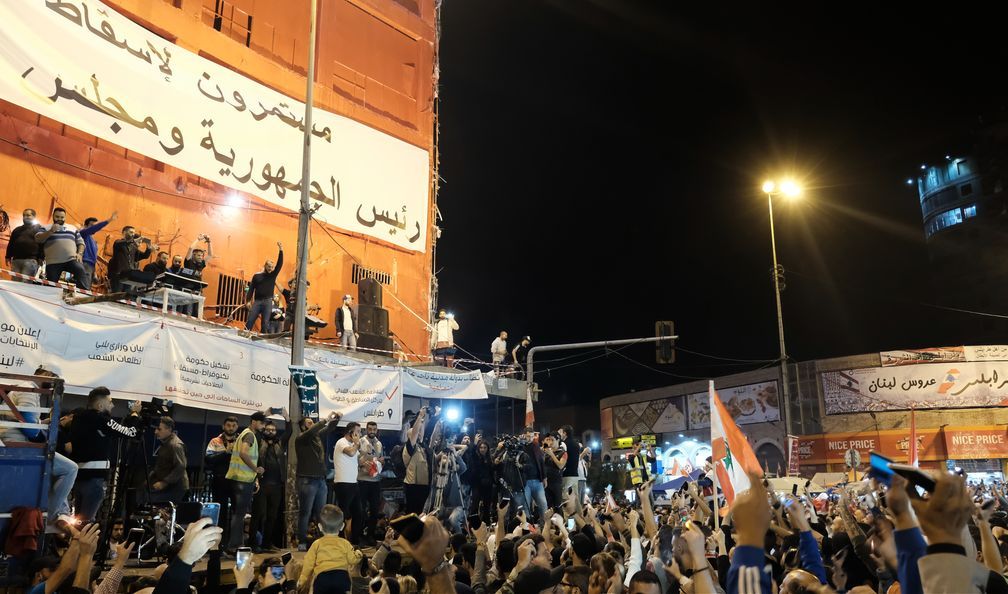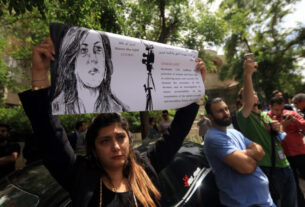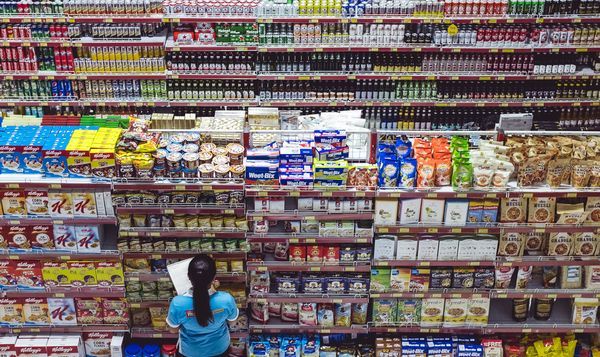Christian Pistor is a member of Linkse Socialistiche Partij / Parti Socialiste de Lutte (ISA in Belgium).
The lockdowns across much of the planet put an end to the wave of massive street protests in countries such as Iraq, Algeria, Chile, France and Hong Kong in 2019. Lebanon’s lockdown began in mid-March ending a wave of mass protests which started on October 17, 2019. Now Lebanon appears be the first country to see the re-emergence of the masses onto the streets.
Initially directed against a series of new taxes, part of an unprecedented austerity program, the protest movement grew exponentially. At one point close to two million people were on the streets, about one third of the country’s population, demonstrating their anger at years of neo-liberal policies. Significantly, it cut across sectarian divisions.
As it progressed, the demands of the protesters became more radical, demanding the resignation of the government and an end to the country’s sectarian political system. The Prime Minister was forced to resign. Social demands included a progressive tax system, social security, and massive investment in the water and electricity networks. Young people, including many women, played a critical role in maintaining the momentum of the protests. The movement, however, was undermined by the lack of democratic structures and leadership, and the absence of independent working-class organizations.
The economic context
Lebanon is highly reliant on imports. Eighty percent of the food supply and nearly ninety percent of consumer goods are purchased abroad. The country’s economic model relies on consumption rather than production. By 2017, the service sector accounted for four fifths of its GDP. Remittances from Lebanese working abroad are crucial to the economy, accounting for 12.7% of GDP, the eighteenth highest such figure in the world. With most of the migrant cash transfers originating in the Gulf States, they are highly dependent on petrodollars, and as oil prices have been falling since the crisis of 2008, remittances have stagnated. The recent collapse in oil prices will mean remittances will dry up even further.
Aside from Lebanon’s profoundly corrupt and sectarian political system, geopolitical factors, including the eight-year civil war in neighbouring Syria, a rift with Saudi Arabia in 2017, and US sanctions against Iran, worsened the demise of the country’s economy which has had an average growth rate of 0.3% over the past decade. Of course, the latter figure must be seen in the context of sluggish worldwide growth since the crisis of 2008–09.
Economic crisis sharpens
Already in November 2019, the World Bank was predicting that the number living in poverty would rise from 30 to 50% in 2020. At the beginning of the year, the unemployment rate stood at 46%, according to Lebanon’s president. Overall, two thirds of those who were employed were earning low wages. This was before the coronavirus lock-down further aggravated the situation.
Lebanon has the highest proportion of refugees per capita in the world, with Syrian refugees alone accounting for a quarter of the country’s 5.9 million population. An incredible 97% of refugees work in the informal sector, which accounts for 55% of the Lebanese economy. This puts them in the most danger from the virus and hunger.
Despite restrictions on withdrawals, bank deposits plunged $5.7 billion in the first two months of this year alone according to the Prime Minister. Much of this money is likely to have left the country, with a much smaller proportion being stashed in people’s homes. Although in March, the government blocked further dollar withdrawals and transfers abroad were banned, the Prime Minister still complains that capital flight continues. Small savers have practically lost access to any money they had in dollars, whilst Lira sums evaporate away due to inflation, but the wealthy are still able to transfer their fortunes abroad. It is these capital controls and the sense of injustice inherent in the situation which has fuelled anger at the banks.
With national debt ballooning, and currently standing at 170% of GDP – one of the highest in the world – on March 9, Lebanon’s government defaulted on a $1.2 billion Eurobond. This was Lebanon’s first ever sovereign default. Currently the IMF predicts that the economy will contract by 12% in 2020, following a 6.5% contraction in 2019. The pandemic and the accompanying lockdown have only compounded an already very dire situation.
The last months have seen the Lira effectively losing two thirds of its value. Officially, it is pegged to the American dollar at a rate of 1,507 to one. Yet on the parallel exchange market the currency is now traded, at the time of writing, at 4,300 to one. This has led to an explosion in prices at a time when large swaths of the population, especially those in informal and seasonal work, have been deprived of an income due to the lockdown.
The lock-down
A nationwide lockdown was declared by the government on the 15 of March. Security forces were sent to patrol the streets and a night-time curfew imposed.
It was forbidden to assemble in groups, and non-essential commercial establishments were closed. The government’s pledge to aid the poorest families was not implemented. Nor were any measures taken to protect tenants from eviction. The only measure the government managed was to extend the due date for taxes and utility bills. It was left to civil society organisations, relying on donations, to deliver aid.
Although, the official toll of COVID-19 remains relatively low, standing at 845 people infected and 26 dead as of May 10, the true spread of the virus is likely to be considerably higher due to a scarcity of tests, especially among refugees.
Signs of desperation became evident early in the lockdown. In late March, the picture of an unemployed construction worker offering to sell his kidney to prevent his family ending up on the street went viral on social media. Several attempted self-immolations have also been reported. By the last week of April, the government estimated that 75% of the population required aid, including food aid. Among refugees the figure is estimated to be as high as 90%. Although the lock-down has been eased with some shops allowed to reopen on the April 23, the stay-at-home order has been extended to the May 10.
The rebellion re-surfaces
The first rumblings of the re-emergence of the protest movement were felt on April 21 with protesters across the country riding around in large car convoys draped in the Lebanese flag. One such protest in Beirut targeted a meeting of MPs. They have tended to be quite large and have at times seen the participation of entire families including children. At times festive in character, these protests have included self-made signs and the national flag.
These protests, which respected social distancing rules, were quite tame when compared to those which erupted in Tripoli, Lebanon’s second largest city, on the night of Sunday, April 26, the first to truly challenge the curfew imposed under the lockdown. For the time being, they have been comparatively small, numbering in the hundreds rather than the thousands. This is understandable amidst a pandemic and a lockdown. Those on the street are those sufficiently desperate and/or radicalized to run the risk of infection and state repression. The participants were mainly young men and women fighting it out with security forces using stones and Molotov cocktails. The latter used tear gas and rubber bullets, and in some cases also live ammunition. One 26-year-old man has been killed. In some instances, the support of broader layers of the population for the riots was expressed from their homes by the banging of pans.
Hunger is a recurring theme among protesters. Yet the protesters also continue to demand the resignation of the government. Besides the corrupt and sectarian political system, the banks are seen as being responsible for the crisis. L’Orient le Jour, Lebanon’s widely read francophone daily quoted a protester: “Our protest is not sectarian, it is a class struggle opposing the Lebanese people crushed by the weight of poverty to the banking system which is responsible for the deterioration of the economic situation.” It is no coincidence that as demonstrations spread to other cities on the second consecutive night of protests fifteen Lebanese banks were targeted with arson and vandalism.
Amidst all of this, the Prime Minister Hassan Diab and the head of the Central Bank, who has held the post since 1993, have been trading accusations about who is responsible for the economic crisis. In the eyes of broad layers of the population it is no doubt both the government and the banks which have lost all credibility. The army command meanwhile has blamed “infiltrators” for stirring up the violence.
After four days of violent confrontations between demonstrators and security forces the government was forced to adopt an economic rescue plan. The government hopes to secure a $10 billion loan from the IMF, in addition to the freeing up of $11 billion pledged in 2018. This, however, will not happen before major political and economic reforms, as well as anti-corruption measures are implemented. It is estimated that Lebanon needs at least $80 billion to emerge from its predicament. Such funds will not easily be found, especially during a deep world economic crisis.
The reforms demanded by the IMF will, of course, not favour the working class and oppressed. Just one example is that the rescue plans foresees the devaluation of the Lira to a rate of 3,500 to the dollar, which will more closely reflect its real value but will also set recent price rises in stone. It is precisely these price rises that for much of the population have become a question of life and death. This inability of the political and economic system to assure the most basic short term needs of the masses is a recipe for the continuation and the growth of the protests.
A sign of things to come?
Although the Lebanese case might be special, due to its economy having already experienced a severe crisis last year, events there are likely to be a harbinger of things to come elsewhere. Indeed, a severe global economic crisis was expected to develop prior to the pandemic. As such, developments in Lebanon might only be running a bit ahead of the general trend, and indeed hundreds of protestors have already appeared on the streets in neighbouring Iraq.
In Lebanon, as elsewhere, the pandemic and the measures taken to contain it are laying bare all the existing contradictions. The world emerged from the crisis of 2008–09 at the cost of a massive increase in indebtedness. Debts are set to soar further with the current crisis. Likewise, the issue of capital flight, a prominent ingredient in the Lebanese drama, is also being sharply posed throughout the neo-colonial world. So far, capital flight from “emerging economies” is already four times greater than in the crisis of 2008–09. Moreover, the Lebanese state is far from being alone in facing possible bankruptcy in the period ahead.
Whilst the general global tendency in the next period is for deflation, due to the drop in demand particularly in sectors such as tourism and services, in countries such as Lebanon, as a result of currency devaluations, inflation and even hyperinflation may for periods dramatically fuel discontent.
Besides Lebanon, the economies of countries such as Jordan and Egypt are also likely to suffer from a drop in remittances from the Gulf States due to the fall in oil prices. The problem goes far beyond the availability of petrodollars. Since migrant workers tend to be more vulnerable to the loss of employment or wages, a fall in remittances will be a worldwide problem. The World Bank predicts a 19.7% fall in remittances to low and middle-income countries in 2020, the sharpest decline in recent history.
Lebanon is also far from exceptional when it comes to the economic vulnerability of its population to lockdown measures. The International Labour Organization in 2018 reported that two billion people, or 61% of the employed population worldwide, work in the informal economy. Even in the formal economy, jobs are often insecure and unemployment benefits far from guaranteed. With the United Nations predicting famines of “biblical proportions” hundreds of millions might soon be pushed to rebel by the spectre of hunger.
Political Tasks
There is an urgent need to build independent working-class organizations, including independent, combative trade unions so that the working class can take the leading role in the movement. This is crucial if the re-emergence of sectarian divisions among the masses is to be prevented.
The working class also needs its own political organization, with a revolutionary socialist outlook. The dire situation seen in Lebanon clearly demonstrates that reforming the current system is not an option. There is no room left even for limited social advances.
Working people and the oppressed masses need to organize in their workplaces and their neighbourhoods. Democratically elected committees formed on this basis are needed to assure that peoples’ basic needs, such as food and health, are met as well as to control prices. Resources and work must be organized to this end.
The linking up of these committees could form the basis of a revolutionary constituent assembly to replace the current sectarian-based and corrupt political system and take over the banks, natural resources and means of production as part of a democratically managed planned economy, a socialist economy, so that the needs of ordinary people are met.
Both the economic crisis and the pandemic are global; they require an international response. The movement of the working class and the oppressed in Lebanon would receive incredible solidarity if an appeal to their brothers and sisters throughout the Middle East and internationally was to be made. More than this, however, the resolution of the economic problems will not be possible if a planned economy was to exist just in Lebanon alone; it is therefore crucial that links are forged with workers’ movements in other areas so that a Socialist Lebanon could be part of a wider democratic Socialist federation of the Middle East.




